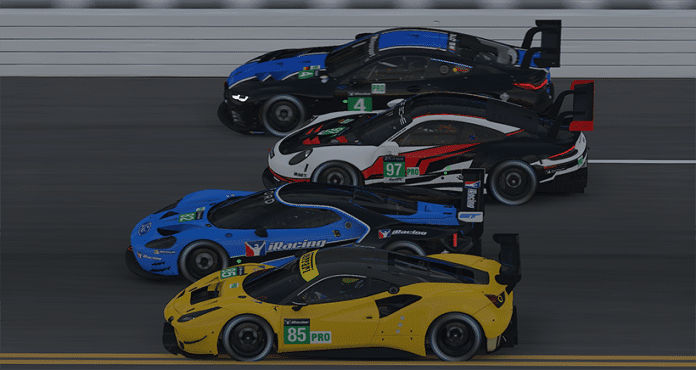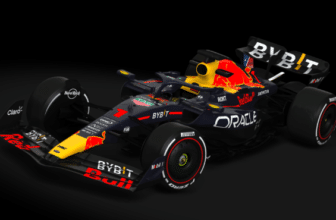
Have you developed a passion for simracing and want to take it to the next level? Endurance sim racing is one of the most popular events for car simulation enthusiasts. Even professional drivers like Fernando Alonso and Max Verstappen have taken up the sport.
But in endurance racing, being the fastest on a lap won’t do you any good. Performance, resilience, extreme concentration and consistency are the keys to a place on the podium.
And in simracing as in real racing, many parameters can make the difference between a successful race and a total fiasco. Here’s a list of 11 recommendations to help you prepare for your race in the best possible conditions!
1 – Make sure your PC and screens are battle-ready!
This may seem obvious, but I’ve seen a lot of drivers fooled by an untimely Windows update. So make sure your PC is up to date. Update all your simulations and disable all automatic updates for the duration of the race.
As for the screen(s), please don’t forget to disable the automatic sleep function. It’s a detail you don’t necessarily think about when you’ve never done an endurance run before. It’s a detail you don’t necessarily think about when you’ve never done endurance racing before, and it can either send you crashing (in the best case) or trigger a chain reaction that ruins the race for many other drivers.
2 – Driving position
Endurance simracing is also a challenge for your body. You’ll be in the same position for hours on end. The slightest discomfort can wear you down mentally, and eventually push you over the edge. So take your time to find the most comfortable position on the track. If you need help, here’s a link to a tutorial on racing ergonomics.
3 – Check that your equipment is securely fastened
I don’t know many simracers who take the trouble to check that their equipment is properly secured before a race. When I talk about it, the answer I’m often given is: even if a component is a little unscrewed, it won’t come off like that!
But here’s a concrete example. A pedalboard slightly unscrewed from the cockpit isn’t suddenly going to fly off across the room. On the other hand, it’s quite possible that every time you brake, you’ll hear the screw playing in its pitch. Dangerous? No, but your concentration will suffer. And in endurance simracing, concentration is everything.
Check your screws. It only takes 2 or 3 minutes, and you’ll be sure that if there’s a problem, it won’t come from there.
4 – Time passes and light changes
It’s not just in your simulation that the weather changes in real time… Outside, it works too! And if your cockpit is near a window, there’s a good chance that at some point you’ll be bothered by reflections or reverberations. Visual discomfort quickly tires your brain and ruins your ability to concentrate. So, before the race, it’s best to close the curtain or shutter. You need to retain control over the brightness of the room.
In simracing endurance racing, you’ll need different functions than in fast racing. You’ll experience changes in the weather, and maybe even a day-night cycle. So you’ll need to configure your buttons a little differently.
So we start with a Pit Stop button, as well as buttons to modify your pit stop strategy. Headlights and wipers are also essential in endurance racing. You’ll also need buttons to adjust your TC (traction control) during the race, as well as theABS.
And don’t forget to add buttons to increase and reduce the FFB. After several hours of riding, you may find that your arms ache a little. Lowering the FFB by a few % will help you finish in good condition.
6 – Teamwork
Building a solid endurance team can take months or even years in the real world. And if you thought you’d just jump into endurance simracing with the first-timers and throw yourself into the arena, you’re in for a disappointment.
You need to spend time with your team.Training together, getting to know each other and each other’s strengths and weaknesses. You can work out your strategy, discuss each other’s racing preferences and your performance. Your team-mates aren’t just there to take turns. They’re there to take you to the next level and win with you.
Setups in simracing are almost an art. It’s complex enough in simple races, but in endurance racing, it’s a whole new level of difficulty.
It’s not all about having a fast set-up. You’ll also need to make sure that your tires are as well-preserved as possible, and that you’re carrying enough fuel to last until the next scheduled stop.
Your setups should also include pre-recorded stop strategies. This will save you having to enter all the data manually during the race. Of course, you can adjust these strategies during the race to suit the weather, for example. But these adjustments will be quick and effective.
6.2 – Practice driver changes
Driver changes always look super-simple on paper or on YouTube videos… But in fact they require coordination and discipline. And you’re going to be under a lot of pressure as the race is on the line.
So take the time with your team-mates to practice several times. Learn how to let go of the steering wheel and how to take it. Master the process so that it’s almost automatic for you once you’re in a race situation.
7 – Racing comfort also involves clothing
As we saw earlier, endurance simracing means hours spent in the same position. And beyond your driving position, your clothing will also play its part in your race. Choose loose-fitting sportswear and an anti-sweat T-shirt. This will improve your comfort during the race, and with it your ability to concentrate.
Take care of your hands too. Over long sessions, your steering wheel can start to irritate the inside of your thumbs, for example. The solution? Gloves. A pair of gloves will ensure you avoid those unpleasant rubbing sensations, while protecting your steering wheel.
If, like me, you’re used to driving in socks, make sure that they don’t get in the way over long distances. As for me, for endurance races I prefer a light pair of shoes with thin soles. That way, I don’t wear out my feet on long sessions, while still retaining maximum sensations.
8 – Have a water bottle and energy bars to hand
Sport takes its toll! And so do endurance races. So remember to pack a water bottle and energy bars for the duration of your relay. My advice:
Always prefer a flask to a glass or bottle. All it takes is one sudden movement of your steering wheel to spill the contents of a glass or bottle onto your lap. If this happens, you’ll be totally unfocused for several seconds. Accident waiting to happen!
When you feel thirsty, wait until you’re on a clear straight stretch of road. If necessary, lower your FFB by a few % to keep control of your steering wheel with just one hand.
For energy bars, don’t forget to open them in advance! Just so you don’t find yourself tearing the wrapper off with your teeth as you overtake..
9 – Physical preparation
The night before the race, go to bed early. Your sleep is a key factor in managing your concentration. Obviously, no alcohol or “other” drinks before the race. Substances that are dangerous when driving in real life are also dangerous when simracing.
In the last few minutes before the start, a few stretches will help your body to wake up. It’s normal to feel a little stressed before the start. Try to relax as much as possible. Listen to some music if that helps. Remember, you’re here to have a good time and enjoy your passion. Take a deep breath and settle into the cockpit. Are you comfortable? Then line up on the starting grid!
10 – Regularity and safety
In endurance racing, there’s no point in running. The golden rule is consistency and safety. Let the crazy drivers kill each other on the first lap, and do your utmost to drive as cleanly as possible. Stay focused, avoid contact.
In every race you’ll see some very fast drivers taking the lead by forcing their way through every bend. Don’t play into their hands. A few laps or a few hours later, you’ll be surprised to overtake them when they blow up their car in a risky last-ditch attempt to overtake.
If you’re pushing yourself to the limit and gaining 1 second per lap, all it takes is one wrong turn or contact to lose you 10 or 20 laps of progress. If you don’t have to forfeit, of course..
Consistency and safety will take you much higher up the rankings in your first endurance races. You’ll have the choice to be more aggressive when you’re more experienced!






